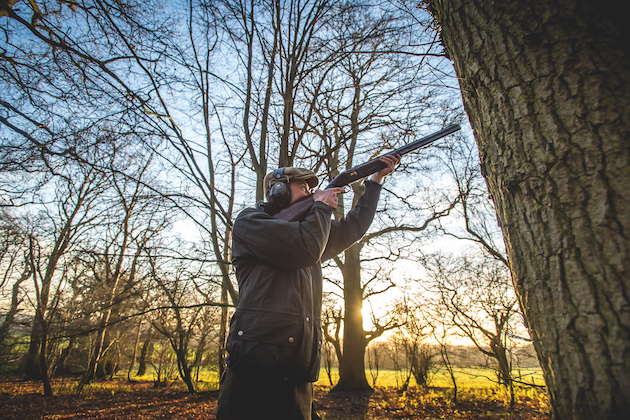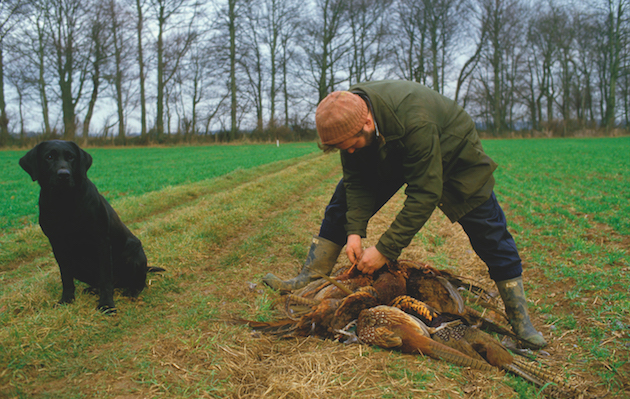Win CENS ProFlex DX5 earplugs worth £1,149 – enter here
Is British shooting in danger of selling itself short?
 Man shooting
Man shooting
The television series Jack’s Game was first screened on Channel 4 in 1983. In one episode, the cameras follow Jack Charlton, two of his friends and their dogs as they walk-up some wild and wonderful land on their rough shoot.
Jack ruefully points out that the money they spend on sporting rights, releasing and feeding 100 birds and myriad other expenses makes their bag of seven pheasants and one brace of teal a costly haul.
Some say that, since those halcyon 1980s days, game shooting has become too cheap and too gluttonous, citing this as the cause of overproduction and the resulting devaluation of game.
Price of shooting
Sam Carlisle, shooting campaign manager for the Countryside Alliance, said: “I think the price of shooting is affordable rather than cheap, particularly if you live in a truly rural area. Shooting is remarkably good value if you compare it with other adventurous sports, such as skiing or sailing.”
This is an important point. There is a gulf of difference between ‘cheap’ and ‘affordable’. Cheap implies a lowering of quality and cost. Affordable suggests something is reasonably priced and attainable.
Comparing 1983 with today, our average salaries are now 24% higher, fuel costs 24% lower and our groceries shop is 54% less costly.
Shoots in the early 1980s faced markedly higher costs. In 1980, wheat prices were £105 per ton (£453.60 in today’s money), pheasant poults were nearly three times the price. Thus, due to basic economics, in the early 1980s fewer people went driven shooting or if they did, they shot fewer birds.
Some commercial shoots may be missing a trick if they fail to offer a full range of shooting experiences
I wonder what Jack would think about today’s ready availability of shooting and an average driven pheasant costing a mere £30, or £29 for a partridge.
This all supports Sam’s comments. Shooting hasn’t become cheap; it is simply more affordable because we have more disposable cash. If there is a problem with shooting, it could be argued that this new-found affordability has led to potentially negative consequences.
Increased affordability of shooting has largely resulted in two scenarios. Either you shoot more birds in one day, though the fetish for shooting large bags seems to be on the wane, or you go shooting more often.

A day’s shooting is now more affordable than in the 1980s
Environmental impact
Recent research by the GWCT and Exeter University found a clear correlation between the numbers of birds released per acre and either a positive or negative environmental impact. However, with a record number of people wanting to go shooting more often — and being able to afford to do so — shoots are under pressure.
Many shoot owners argue that the only way they can accommodate the glut of punters is to stock more birds. While some shoots can release more birds without creating negative environmental impacts, many clearly can’t. The result is that some shoots find themselves unable to cope with demand or, worse still, cutting corners, leading to net biodiversity losses.
This then begs the question, are these commercial shoots missing a few tricks? Some savvy shoots are catering for the high demand by fully utilising their resources — additionally selling roost shooting, goose shooting over stubbles, walked-up boundary days or even corvid control days. This variety suits a range of pockets and tastes, and does not necessitate more stocking. Many shoots focus solely on selling driven shooting, usually because of the ease of pricing it up and selling it in a standard sales matrix — cost of production plus percentage mark up equals price charged.
It has been argued that these driven shoots have, almost inadvertently, fallen into knowing the price of everything, but the value of nothing. The sport can be seen as being cheapened or, as Margo Leadbetter from The Good Life would have said, “reeking of trade”.
There is a way of marketing and selling a product for more money that avoids increasing production or lowering standards, a model that shooting has been slow to embrace. This is surprising because it is a strategy that supports net biodiversity gains. It is the world of ‘luxury lifestyle’.
A shoot day is about the whole experience, including a good lunch, not simply the shooting
What is luxury?
I asked the former head of design for one of the world’s leading luxury brands to give an informed view of what constitutes ‘luxury’. “The model adopted by luxury brands is very much to look at the overall picture. Every facet of the product is meticulously crafted and presented to the customer with seemingly effortless elegance. Rarity, exclusivity, uniqueness and bespoke are the drivers of desire for luxury goods, often wrapped up in an unforgettable (Instagrammable) experience. Quantity is limited intentionally.”
These words are worth noting, particularly as they come from my wife. Luxury brands price products not simply by the standard sales matrix, but add into the mix the rarity, exclusivity and experience of the offering. These are intangible and potentially have a very high value.
Jake Fiennes, the head of conservation at Holkham, described how days at this most iconic of sporting estates were sold. “Shooting here is not about numbers, it is all about the experience. A team of game Guns on one of our Holkham experience days shoot what gives them pleasure, bag numbers are not even a consideration. The covers they stand before are as old as driven shooting itself, the bowler-hatted keepers are a timeless image, lunch is a memorable occasion for Guns and their guests. The wildlife they see is as important as the game they shoot.”
Holkham appears to have grasped the principle of luxury. What Guns are paying for is an opportunity, for a few hours, to enter a shooting world that is the perfect sum of each perfect part. To put it into the terms of horse racing, Huntingdon and Cheltenham racecourses have the same product. Yet tell a non-racing friend that you are off to Huntingdon to watch the Peterborough Chase and you may get a watery smile. Tell him you are off to the Cheltenham Festival and your stock rises. Cheltenham is marketed as a luxury brand, Huntingdon isn’t.
If you believe the narrative, at Cheltenham the tweeds are tweedier, your fellow racegoers are racier, the food more sumptuous and the wines finer. Everything also costs more, yet people are willing to pay this simply for the Cheltenham experience, despite the core product at the two tracks being more or less the same.
One of shooting’s leading detractors uses the cost of a day’s driven shooting as a ready weapon against the sport. This director of Wild Justice also proudly boasts his long-standing annual membership of Cheltenham Racecourse. Luxury is chiefly about exclusivity, rarity and kudos. Therefore the most successful sporting agents are not those who have access to shoots stuffed with game, but those who have a little black book stuffed with numbers of exclusive hosts with rare offerings. How you price up luxury is nearly impossible to quantify, because luxury has nothing to do with cost; it is all about valuing experience. Thus, to sell this good life, agents need to be marketeers rather than market traders, something Margo Leadbetter would find much more attractive.
Charging a premium
Shoots such as Holkham succeed because of their unique location, history and environmental credentials. They also offer a unique experience and, as such, they can charge a premium for this experiential treat.
The number of birds you shoot is irrelevant and has no bearing on the price of shooting. The same can apply to any shoot. All have their own unique offerings and experiences. You do not necessarily have to pay thousands of pounds nor to stand in the grounds of a ducal home to have a luxurious day out.
It seems many excellent shoots are losing out because they merely sell themselves on the strength of their driven shooting, forgetting that discerning Guns are looking for variety and are prepared to pay for it. They also neglect to market other benefits that Guns receive — being a part of a superb conservation story, meeting the host of characterful keepers and beaters, eating the best sausage rolls ever tasted or experiencing new sights.
Shooting costs less than it did 40 years ago, which is good because now we can all afford a little luxury.
Related Articles
Get the latest news delivered direct to your door
Subscribe to Shooting Times & Country
Discover the ultimate companion for field sports enthusiasts with Shooting Times & Country Magazine, the UK’s leading weekly publication that has been at the forefront of shooting culture since 1882. Subscribers gain access to expert tips, comprehensive gear reviews, seasonal advice and a vibrant community of like-minded shooters.
Save on shop price when you subscribe with weekly issues featuring in-depth articles on gundog training, exclusive member offers and access to the digital back issue library. A Shooting Times & Country subscription is more than a magazine, don’t just read about the countryside; immerse yourself in its most authoritative and engaging publication.







